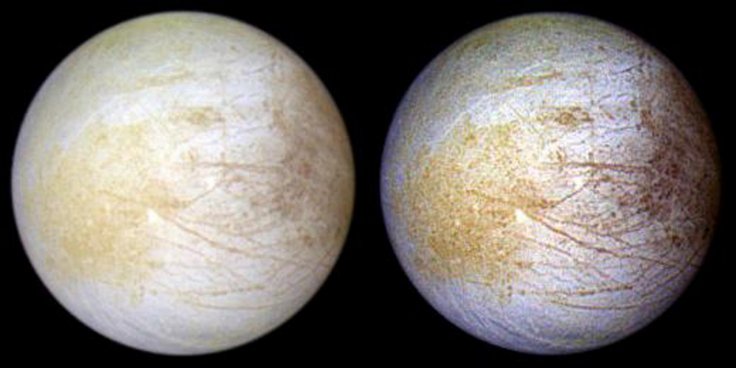
It was widely believed that Jupiter's moon Europa has water and magnesium sulfate salts, similar to bath salts. However, the scientists are excited to find the yellow cracks seen in the image above are indeed reflections of sodium chloride or table salt that we use daily in our lives.
These salt oceans, hidden beneath an icy shell, are part of the Tara Regio visible in this NASA Galileo image of Europa's surface, which is believed to a region of geologic chaos but abundant in sodium chloride. The near-infrared spectroscopy data of Europa in the past from the Galileo spacecraft showed the yellow patches but scientists were not able to pin-point what the compound was.
This time, using higher resolution data from the W. M. Keck Observatory, they said it was sodium chloride and explained that since sodium chloride can't be seen with near-infrared spectroscopy, it was not captured in Galileo data. But the mineral, known as table salt in common parlance, can be seen using light in the visible spectrum and a special process of radiation.
"Sodium chloride is a bit like invisible ink on Europa's surface... Before irradiation you can't tell it's there, but after irradiation the color jumps right out at you," explained JPL scientist Kevin Hand, who probed the irradiation process to spot sodium chloride as yellow patches in Europa's images.
In fact, this could have been done using Hubble telescope. "We've had the capacity to do this analysis with the Hubble Space Telescope for the past 20 years. It's just that nobody thought to look," said Mike Brown, Professor of Planetary Astronomy at Caltech and coauthor of the paper .
Now that they found salt, they were able to confirm it using the Hubble telescope. "People have traditionally assumed that all of the interesting spectroscopy is in the infrared on planetary surfaces, because that's where most of the molecules that scientists are looking for have their fundamental features," said Brown.
The research paper about the findings has been published in the journal Science Advances.








